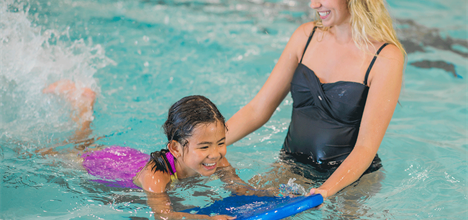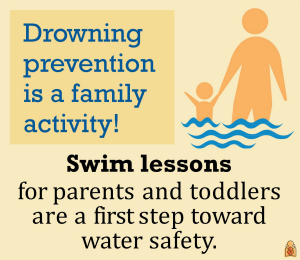How Young Can You Teach a Baby to Swim
Safety & Prevention
Swim Lessons: When to Start & What Parents Should Know


Page Content
Learning to swim should be a priority for every family. It's an important life skill that tin can play a key office in helping to prevent drowning―a top cause of expiry among children. Children, and their parents, need to learn how to swim to assist proceed time in the water safe and fun!
Here are some tips from the American University of Pediatrics (AAP) on the best fourth dimension to start swim lessons and what to await for in a quality learn-to-swim plan.
When should my kid learn to swim?
Children develop at different rates, and not all are set up to begin swim lessons at exactly the aforementioned age. When making your decision, proceed your kid'southward emotional maturity, concrete and developmental abilities and limitations, and condolement level in the h2o in mind.
The AAP recommends swim lessons as a layer of protection against drowning that tin can brainstorm for many children starting at age 1.
 Parent-child toddler & preschool swim classes: benign for many families
Parent-child toddler & preschool swim classes: benign for many families
- Recent studies suggest that h2o survival skills training and swim lessons tin aid reduce drowning run a risk for children between ages 1-4. Classes that include both parents and their children also are a adept way to introduce skillful water safety habits and start edifice swim readiness skills. If your kid seems ready, it'southward a good idea to beginning lessons now.
Swim lessons for children ages 4 and up: a must for almost families
- By their 4th altogether, nearly children are fix for swim lessons. At this age, they usually tin can acquire basic water survival skills such as floating, treading water and getting to an get out point. By age v or six, nearly children in swim lessons can principal the front crawl. If your child hasn't already started in a learn-to-swim plan, now is the time!
Does AAP recommend infant swim classes?
- No, considering there is currently no evidence that infant swim programs for babies nether 1 year onetime lower their drowning risk. Infants this age may evidence reflex "swimming" movements but can't yet raise their heads out of the water well enough to breathe. It's OK to enroll in a parent-kid water play class to help your infant get used to existence in the pool, though; this tin can exist a fun activity to relish together.
Call back, swim lessons don't make kids "drown proof."
- Always keep in mind that swim lessons are only 1 of several important layers of protection needed to aid forestall drowning. Another layer includes constant, focused supervision when your child is in or near a pool or any trunk of water. Information technology besides is essential to block admission to pools during non-swim time. The Consumer Product Safe Commission constitute that 69% of children under the age of 5 years were not expected to exist in the water at the fourth dimension of a drowning.
What should I wait for when choosing swim lessons?
Look for classes and instructors that follow guidelines focused not simply on swim stroke techniques, but broader water survival competency skills. All children should learn how to get back to the surface from under water, propel themselves at least 25 yards, and get out of the water, for example. Instructors should evaluate children's progress and give ongoing feedback on their skill levels.
For children of all ages, await for programs that:
-
Accept experienced, qualified instructors. Swim instructors should exist trained and certified through a nationally recognized acquire-to-swim curriculum. There should also be lifeguards on duty who have current CPR and Showtime Aid certification.
-
Teach good safety habits in, on, and well-nigh water. Children should learn to never swim alone or without adult supervision. Instructors should teach children to always inquire for permission from parents, lifeguards, or swimming instructors before they get into a pool or natural bodies of water like a lake.
-
Teach what to do if they end upward in the water unexpectedly. This includes practicing water competency skills such every bit self-rescue. Lessons should provide training with a variety of realistic atmospheric condition, such as falling in and swimming in clothes. Older children also should learn what to practise if they see someone else in the water who is struggling, and how to go help.
-
Let yous sentinel a class starting time to come across first-mitt if information technology is right for your child. Not all swim lessons are created equal, and parents should investigate options to choose the all-time fit. Are they swimming most of the time, or are there long periods of inactivity where they are waiting for their turn? Do children become one-on-ane attention? Are the instructors friendly and knowledgeable?
-
Crave multiple sessions. Once children start lessons, y'all should exist able to run into gradual but consistent progress in their abilities over time. Continue lessons at to the lowest degree until your they chief basic water competency skills.
In addition, for children under age iv, look for programs that:
-
Provide an historic period-advisable temper. Your child should feel safe and secure during lessons, with activities that back up their social, intellectual, physical, and emotional development. However, children need to develop a salubrious respect for water, also.
-
Include "touch supervision." Whenever infants and toddlers are in or around water—even during swim lessons―an adult should be within arm's accomplish to provide "touch supervision." Parent participation should exist encouraged, specially since information technology as well helps families know what to practice in between classes. If you can't exist in the h2o with your child, look for individual classes that offering 1-on-1 instruction.
-
Maintain water purity. Immature children are more than probable to swallow or breathe in water, so water disinfection and maintaining proper chlorine levels is really important. A good plan should also require the child to wear a swimsuit that is snug-fitting at the legs to assist avoid spreading body waste into the water.
-
Keep the water warm. Hypothermia is a greater risk at this age. Ideally, swim and water safety classes for children historic period iii and younger should be in water heated to 87 to 94 degrees Fahrenheit.
When the toll of swim lessons is a business concern:
If you're worried your family tin can't beget swim lessons, check with your city government. Many towns have scholarship programs that help cover the cost of swim lessons held at public pools. Reach out to qualified instructors virtually possible payment plans or scholarship options.
How to supervise your child in or about water:
Proper supervision in the water—fifty-fifty if your child is learning how to swim―is one of the nigh important means to help forbid drowning. Drowning is quick, silent, and much more common than virtually families realize. Information technology happens every day to children with loving, attentive parents and caregivers.
To effectively supervise and keep your child rubber during swim time, keep in mind:
-
Pay close, constant attention. Do not get distracted with other activities (such as reading, playing games, using the cellphone, or mowing the lawn), even if lifeguards are present.
-
Avoid using alcohol or drugs around the water, especially when supervising others.
-
For younger children and weak swimmers, get in the h2o with them. "Bear upon supervision" is essential! Even if y'all are not pond but there is a pool or trunk of water nearby, e'er continue children within arm's reach. If you must leave, take the child with you.
-
Don't get out a baby or young child in or near any trunk of water under the intendance of some other child.
-
Especially during parties or picnics at the puddle or lake, when it's piece of cake to get distracted, assign a "water watcher" whose job is to constantly keep eyes on the child in or most the h2o. Have turns, passing along a water watcher bill of fare to the next responsible adult after a set up fourth dimension (such as fifteen minutes).
-
Remember that the primary drowning risk for toddlers age 1-iv is unanticipated, unsupervised access to water. Children are naturally curious and unremarkably slip away unnoticed during non-swim times.
-
Always use life jackets when in, on or almost natural bodies of water, such every bit lakes or rivers. Make sure they fit properly and are approved by the U.S. Coast Baby-sit. Children. Weak swimmers should likewise wear life jackets when at a pool or water park.
-
Know how to recognize signs of distress and answer when there is trouble. Anybody, including parents, caregivers and older children, should learn CPR and safe rescue techniques to reply to a drowning incident. Water safety is a family affair!
Call back:
Enrolling in quality swim lessons―once your child is set for them―is i of several essential means to assistance prevent drowning. Talk with your pediatrician if you take any questions about whether your child is developmentally set for swim lessons and how to observe a quality program for your family.
Boosted Information:
-
Infant H2o Safety: Protect Your New Infant from Drowning
-
Drowning Prevention for Curious Toddlers: What Parents Need to Know
-
Water Safe for Teens
-
Pool Dangers and Drowning Prevention―When It's Not Pond Time
-
Keep Kids with Autism Safe from Wandering: Tips from the AAP
-
AAP Drowning Prevention Campaign Toolkit
-
Water Safety U.s.a.
Article Body
- Concluding Updated
- 3/15/2019
- Source
- American Academy of Pediatrics (Copyright © 2019)
The information contained on this Web site should non exist used every bit a substitute for the medical care and communication of your pediatrician. In that location may be variations in treatment that your pediatrician may recommend based on individual facts and circumstances.
Source: https://www.healthychildren.org/English/safety-prevention/at-play/Pages/Swim-Lessons.aspx
0 Response to "How Young Can You Teach a Baby to Swim"
Postar um comentário